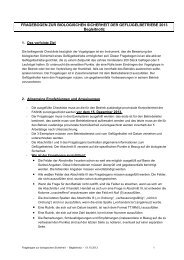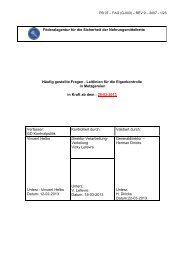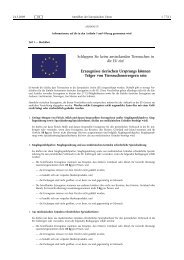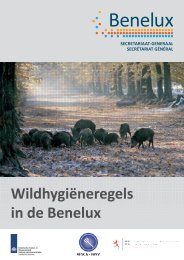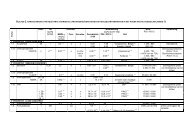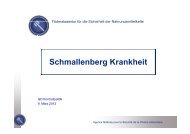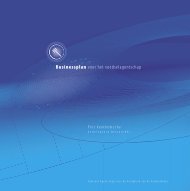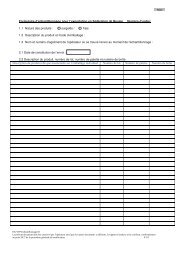Titre de la formation Symposium CIP - Favv
Titre de la formation Symposium CIP - Favv
Titre de la formation Symposium CIP - Favv
You also want an ePaper? Increase the reach of your titles
YUMPU automatically turns print PDFs into web optimized ePapers that Google loves.
1/25<br />
Agence fédérale<br />
pour <strong>la</strong> sécurité<br />
<strong>de</strong> <strong>la</strong> chaîne alimentaire<br />
DG Laboratoires<br />
Cadre I : Données concernant <strong>la</strong> <strong>formation</strong><br />
Fiche <strong>de</strong> suivi et d’évaluation <strong>de</strong>s <strong>formation</strong>s<br />
-<strong>Titre</strong> <strong>de</strong> <strong>la</strong> <strong>formation</strong> <strong>Symposium</strong> <strong>CIP</strong>AC – FAO - OMS<br />
- Durée 09 – 16 juin 2006<br />
- Organisateur <strong>CIP</strong>AC – FAO - OMS<br />
- Nom <strong>de</strong> <strong>la</strong> personne ayant<br />
suivi <strong>la</strong> <strong>formation</strong><br />
A<strong>la</strong>in Dubois<br />
- Coordonnée <strong>de</strong> <strong>la</strong> personne DG <strong>la</strong>bo FLVVG FLVVM FLVVT LFSAGx LFSAL<br />
X<br />
Cadre II : In<strong>formation</strong> DG <strong>la</strong>boratoire<br />
(cadre réservé à l’ administration <strong>de</strong>s <strong>la</strong>boratoires)<br />
-Action à prendre par l’administration <strong>de</strong>s <strong>la</strong>boratoires<br />
Le <strong>la</strong>boratoire <strong>de</strong> Liège adaptera certaines métho<strong>de</strong>s analytiques en fonction <strong>de</strong>s décisions prises lors du<br />
symposium.<br />
-In<strong>formation</strong> à diffuser à :<br />
Comité d’Agréation <strong>de</strong>s produits phytopharmaceutiques.<br />
Cadre III : Evaluation <strong>de</strong> <strong>la</strong> <strong>formation</strong><br />
(Donner à chaque point <strong>de</strong> l’évaluation une note <strong>de</strong> 1 à 5 (1 étant <strong>la</strong> plus mauvaise note)<br />
1 2 3 4 5<br />
La <strong>formation</strong> correspond elle à<br />
votre attente ?<br />
Evaluation du contenu.<br />
Evaluation <strong>de</strong> <strong>la</strong> présentation.<br />
Evaluation <strong>de</strong> l’organisation<br />
générale<br />
Remarques<br />
LAB 00-F 6.2-01-v.01-2006-
Agence fédérale<br />
pour <strong>la</strong> sécurité<br />
<strong>de</strong> <strong>la</strong> chaîne alimentaire<br />
DG Laboratoires<br />
Cadre IV : Programme ou résumé <strong>de</strong> <strong>la</strong> <strong>formation</strong><br />
A. Troisième réunion conjointe <strong>CIP</strong>AC/FAO/OMS sur les spécifications <strong>de</strong>s pestici<strong>de</strong>s<br />
Voir le Summary Record en annexe.<br />
B. 50 e <strong>Symposium</strong> <strong>CIP</strong>AC<br />
2/25<br />
1. Accueil par Monsieur E. STUCKI, Directeur <strong>de</strong> <strong>la</strong> Station <strong>de</strong> Recherche <strong>de</strong><br />
Changins et M. MUELLER, Prési<strong>de</strong>nt du <strong>CIP</strong>AC et Directeur <strong>de</strong> <strong>la</strong> Station <strong>de</strong><br />
Recherche <strong>de</strong> Wä<strong>de</strong>nswil, CH.<br />
2. Présentations :<br />
a. Advances in Analysis of Pestici<strong>de</strong> Residues in Environmental Samples par<br />
M. EARL, Syngenta UK ;<br />
b. Occurrence and fate of glyphosate and AMPA in surface water in<br />
Switzer<strong>la</strong>nd par T. POIGER, Agroscope Wa<strong>de</strong>nswil CH ;<br />
c. Analytical Chemistry of Pyrethrins revisited – lessons learnt from a<br />
market control par B. PATRIAN, Agroscope Wa<strong>de</strong>nswil CH ;<br />
d. The chemical and analytical aspects of polychlorinated dibenzo-p-dioxins<br />
and other persistent organic pollutants par V. CHMIL, Ukraine ;<br />
e. Microbial trans<strong>formation</strong> of hexachlorocyclohexane isomers par<br />
H.P.KOHLER, EAWAG CH ;<br />
f. HPLC/GC Analysis of the impurities bicisthemic acid chlori<strong>de</strong> and<br />
anhydri<strong>de</strong> in <strong>de</strong>ltamethrin technical par A. RAMESH, IIBAT In<strong>de</strong>;<br />
g. Advances in Pestici<strong>de</strong> Formu<strong>la</strong>tion and Delivery par A. BYWATER,<br />
Syngenta UK ;<br />
h. Long <strong>la</strong>sting insecticidal nets – A theoritical physical chemists view par F.<br />
MULLER-PLATHE, Université <strong>de</strong> Darmstad, RFA ;<br />
i. Trace <strong>de</strong>termination of Terpyridines in paraquat and diquat par A.<br />
BOSELEY, Syngenta UK ;<br />
j. Pestici<strong>de</strong>s reduction measures in the Boiron river, a contributor to Lake<br />
Geneva par P. VIOGET, Canton <strong>de</strong> Vaud, Département <strong>de</strong><br />
l’Environnement CH.<br />
3. Poster Session<br />
LAB 00-F 6.2-01-v.01-2006-
3/25<br />
Agence fédérale<br />
pour <strong>la</strong> sécurité<br />
<strong>de</strong> <strong>la</strong> chaîne alimentaire<br />
DG Laboratoires<br />
Quality Control of Pestici<strong>de</strong>s – Report of tests ma<strong>de</strong> at the Laboratory<br />
Quimica Ambiental par M. PIEDADE FUENTES Instituto Biologico GARP,<br />
Brésil.<br />
C. 50 e Réunion annuelle <strong>CIP</strong>AC<br />
1. Réunion technique ouverte<br />
- Accueil par le Prési<strong>de</strong>nt du <strong>CIP</strong>AC, M. MÜLLER.<br />
- Rapports <strong>de</strong>s experts (étu<strong>de</strong>s en col<strong>la</strong>boration) :<br />
- Alpha–cypermethrin LN ;<br />
- Carbaryl ;<br />
- Clodinafop-propargyl ;<br />
- Deltamethrin, wash resistance ;<br />
- Fenthion ;<br />
- Flufenoxuron ;<br />
- Oxamyl ;<br />
- Pendimethalin ;<br />
- Permethrin (2) ;<br />
- Pyriproxifen ;<br />
- Spinosad.<br />
Autres sujets :<br />
- Peer validation of Fenoxaprop- P- ethyl method for stereospecific<br />
i<strong>de</strong>ntity test ;<br />
- Deltamethrin tablets :<br />
- Amendment of MT 192 – Viscosity of liquids.<br />
2. Réunion technique restreinte<br />
- Minutes <strong>de</strong> <strong>la</strong> 49 e Réunion : adoptées à l’unanimité.<br />
- Rapport du Secrétaire.<br />
- Nouvelles métho<strong>de</strong>s :<br />
- Acetamiprid : pas d’évolution par rapport à l’année <strong>de</strong>rnière ;<br />
- Azadirachtin : métho<strong>de</strong> complète ;<br />
- Chlorothalonil : reste provisoire en attendant une décision formelle <strong>de</strong><br />
l’AOAC ;<br />
- d,d-trans cyphenothrin : erreur <strong>de</strong> transcription dans le texte <strong>de</strong> <strong>la</strong><br />
métho<strong>de</strong> ; reste provisoire tant que les problèmes éditoriaux ne sont<br />
pas résolus ;<br />
- Deltamethrin : métho<strong>de</strong> complète ;<br />
LAB 00-F 6.2-01-v.01-2006-
4/25<br />
Agence fédérale<br />
pour <strong>la</strong> sécurité<br />
<strong>de</strong> <strong>la</strong> chaîne alimentaire<br />
DG Laboratoires<br />
- Diflubenzuron : métho<strong>de</strong> complète ;<br />
- Fenhexami<strong>de</strong> : métho<strong>de</strong> complète ;<br />
- Fenthion : reste provisoire pour les GR ;<br />
- Fenoxapropo-P ethyl : métho<strong>de</strong> complète ;<br />
- IR 3535 : métho<strong>de</strong> complète ;<br />
- Methopren : métho<strong>de</strong> complète après contrôle <strong>de</strong> sa <strong>de</strong>scription ;<br />
- Nicosulfuron : métho<strong>de</strong> complète après amen<strong>de</strong>ment éditorial ;<br />
- Picloram : métho<strong>de</strong> complète avec une <strong>de</strong>man<strong>de</strong> d’une métho<strong>de</strong><br />
d’i<strong>de</strong>ntification plus simple (actuellement LC-MS) ;<br />
- Prallethrin : adoptée ;<br />
- Pyraclostrobin : métho<strong>de</strong> complète ;<br />
- Rimsulfuron : reste provisoire tant que <strong>la</strong> firme n’a pas fourni une<br />
version amendée avec <strong>de</strong>s notes.<br />
- Spinosad : métho<strong>de</strong> complète ;<br />
- MT 192 : amen<strong>de</strong>ment accepté : métho<strong>de</strong> complète ;<br />
- MT 193 : reste provisoire, pas <strong>de</strong> nouvelles données. Changement <strong>de</strong><br />
nom : Friability Attrition resistance.<br />
- Discussion sur les composés individuels :<br />
- Alpha–cypermethrin ; provisoire pour <strong>la</strong> teneur en substance active ;<br />
tentative MT pour <strong>la</strong> métho<strong>de</strong> <strong>de</strong> <strong>la</strong>vage. La métho<strong>de</strong> a été développée<br />
pour un type précis <strong>de</strong> moustiquaire ;<br />
- Carbaryl : provisoire ;<br />
- Clodinafop-propargyl : proviso ire ;<br />
- Deltamethrin, wash resistance : voir l’alpha-cypermethrin ;<br />
- Fenthion : proviso ire ;<br />
- Flufenoxuron : provisoire ;<br />
- Oxamyl : provisoire ; <strong>la</strong> firme doit fournir les calculs <strong>de</strong>s résultats<br />
analytiques sans tenir compte du standard interne pour contrôler sa<br />
nécessité.<br />
- Pendimethalin : provisoire ;<br />
- Permethrin (1) : teneur en substance active : provisoire ; LN : voir<br />
l’alpha-cypermethrin ;<br />
- Permethrin (2) : provisoire ;<br />
- Pyriproxifen : provisoire ;<br />
- Spinosad : provisoire pour l’extension aux DT ;<br />
- Peer validation of Fenoxaprop- P- ethyl method for stereospecific<br />
i<strong>de</strong>ntity test : provisoire ;<br />
- Deltamethrin tablets : provisoire ;<br />
LAB 00-F 6.2-01-v.01-2006-
5/25<br />
Agence fédérale<br />
pour <strong>la</strong> sécurité<br />
<strong>de</strong> <strong>la</strong> chaîne alimentaire<br />
DG Laboratoires<br />
- Amendment of MT 192 – Viscosity of liquids : métho<strong>de</strong> complete avec<br />
les amen<strong>de</strong>ments.<br />
- Remp<strong>la</strong>cement <strong>de</strong>s métho<strong>de</strong>s obsolètes<br />
Pas d'évolution <strong>de</strong>puis le <strong>de</strong>rnier symposium.<br />
Proposition : rédaction d’un gui<strong>de</strong> provisoire qui sera discuté lors du prochain<br />
congrès.<br />
- Nouveau numéros <strong>CIP</strong>AC :<br />
Problème avec les sels inorganiques : pas <strong>de</strong> nom ISO.<br />
- Prochaine réunion : le prochain symposium se déroulera à Umha<strong>la</strong>nga Rocks près <strong>de</strong><br />
Durban en Afrique du Sud du 6 au 15 juin 2007.<br />
- Clôture <strong>de</strong> <strong>la</strong> réunion<br />
Conclusions<br />
Lors <strong>de</strong> ce congrès, une nouvelle métho<strong>de</strong> analytique a été proposée comme provisoire et<br />
huit métho<strong>de</strong>s analytiques ou physico-chimiques sont <strong>de</strong>venues officielles.<br />
Pour l’année à venir, <strong>de</strong>s étu<strong>de</strong>s en col<strong>la</strong>boration sont prévues. Comme précé<strong>de</strong>mment, le<br />
<strong>la</strong>boratoire y participera dans <strong>la</strong> mesure <strong>de</strong> ses possibilités.<br />
ir A. DUBOIS<br />
LAB 00-F 6.2-01-v.01-2006-
6/25<br />
Agence fédérale<br />
pour <strong>la</strong> sécurité<br />
<strong>de</strong> <strong>la</strong> chaîne alimentaire<br />
DG Laboratoires<br />
th<br />
THIRD JOINT <strong>CIP</strong>AC/FAO/WHO OPEN MEETING (50<br />
Meeting)<br />
WHO/HQ, Geneva, 12 June 2006<br />
Summary record of the meeting<br />
Agenda<br />
th<br />
<strong>CIP</strong>AC Meeting and 5 JMPS<br />
1 Opening and welcome<br />
…………………………………………………………………….…………… page 1<br />
2 Arrangements for chairmanship and appointment of rapporteurs ….…… page 3<br />
3 Adoption of the agenda ……………….……………………… page 3<br />
4 Summary record of the previous meeting ……….………………………. page 3<br />
5 Summary of actions taken after the 49 th<br />
<strong>CIP</strong>AC and 4 th<br />
JMPS meetings page 3<br />
6 Technical liaison with other organizations …………………….………… page 6<br />
7 National reports regarding <strong>CIP</strong>AC activities and reports from official quality<br />
control <strong>la</strong>boratories ….….……………………………………………………. page 9<br />
8 Proposed new/amen<strong>de</strong>d specification gui<strong>de</strong>lines …………………….…... page 10<br />
9 Status, review and publication of <strong>CIP</strong>AC methods ……………………….. page 11<br />
10 Proposed new/exten<strong>de</strong>d <strong>CIP</strong>AC analytical and physical test methods ... page 11<br />
11 Review and publication of FAO and WHO specifications for pestici<strong>de</strong>s . page 11<br />
12 FAO/WHO priority list and programme for <strong>de</strong>velopment of FAO and WHO<br />
specifications for pestici<strong>de</strong>s…………………………………………………. page 15<br />
13 Any other matters …………..………………………………………………… page 16<br />
14 Date and venue of next meeting ..…..………………………………………page 16<br />
1. Opening and welcome<br />
Dr Morteza Zaim, WHO Joint Secretary of JMPS, welcomed participants to the Third<br />
Joint <strong>CIP</strong>AC/FAO/WHO Open Meeting and noted WHO's pleasure in hosting the event<br />
for the first time.<br />
Dr Markus Müller, Chairman of <strong>CIP</strong>AC, also welcomed participants and expressed<br />
satisfaction that the format <strong>de</strong>veloped for the meeting has evolved into a form that<br />
signals the mutual un<strong>de</strong>rstanding between WHO, FAO and <strong>CIP</strong>AC. He exp<strong>la</strong>ined that<br />
previously the open meeting was held in three parts, separately for <strong>CIP</strong>AC, FAO and<br />
WHO. The joint meeting was a good opportunity to strengthen the liaison between the<br />
LAB 00-F 6.2-01-v.01-2006-
Agence fédérale<br />
pour <strong>la</strong> sécurité<br />
<strong>de</strong> <strong>la</strong> chaîne alimentaire<br />
DG Laboratoires<br />
three organizations. Dr Müller thanked WHO, Dr Lorenzo Savioli and Dr Morteza Zaim<br />
for hosting the event and wished a successful meeting. Dr Gero Vaagt, FAO Joint<br />
Secretary of JMPS, welcomed participants to the open meeting held at WHO premises.<br />
He exp<strong>la</strong>ined that the FAO and WHO are sister organizations with a long history of<br />
working together and sharing the coordination of this well recognized body for standard<br />
setting. This was the second <strong>CIP</strong>AC meeting held at WHO headquarters; the first was in<br />
1988. Dr Vaagt exten<strong>de</strong>d thanks to Dr Zaim for hosting the event and to all those<br />
involved in its preparation, especially Ms Avi<strong>de</strong>h Denereaz and Dr Lorenzo Savioli.<br />
When the joint meeting was <strong>de</strong>signed by the two organizations, It was consi<strong>de</strong>red that<br />
meetings be held every fifth year either at the FAO in Rome or at WHO/HQ in Geneva.<br />
Dr Markus Müller was thanked for his thoughtful input to the joint meeting and for<br />
presenting his beautiful country during the excursion.<br />
The 5 th<br />
JMPS was a very special meeting, with increased participation as well as<br />
increased interest from Latin America, India and other parts of Asia. This commitment<br />
signals the importance of pestici<strong>de</strong> quality and the impact of JMPS, with FAO and WHO<br />
specifications, to the issue. The relevance of JMPS is expanding and it is now<br />
recognized as a global standard setting body. Equivalence <strong>de</strong>termination, as <strong>de</strong>tailed in<br />
the FAO and WHO manual, is being adopted around the world with continuing increased<br />
interest in this approach. The quality of pestici<strong>de</strong>s is very important to governments and<br />
it should be recognized that JMPS has an important role. However, as for all<br />
organizations, funding issues are becoming increasingly important and governments<br />
should therefore recognize the important role of JMPS.<br />
Dr Lorenzo Savioli, Director, Department of Control of Neglected Tropical Diseases,<br />
welcomed participants to the meeting on behalf of WHO and thanked the Swiss Fe<strong>de</strong>ral<br />
Research Station for Horticulture, Wä<strong>de</strong>nswil, for its cooperation and col<strong>la</strong>boration in coorganizing<br />
the meeting. He noted the wi<strong>de</strong> representation at the meeting from<br />
international organizations, pestici<strong>de</strong> registration authorities, national pestici<strong>de</strong> quality<br />
control <strong>la</strong>boratories, aca<strong>de</strong>mia and research institutions and the pestici<strong>de</strong> industry.<br />
Dr Savioli stressed the importance of the open meeting as a forum for exchange of<br />
in<strong>formation</strong> that sought the views of all interested parties on quality standards for<br />
pestici<strong>de</strong>s and the test methods in support of pestici<strong>de</strong> specifications.<br />
Many of the neglected tropical diseases, including sleeping sickness, schistosomiasis,<br />
river blindness, elephantiasis, <strong>de</strong>ngue and blinding trachoma, rely on vector control and<br />
the application of insectici<strong>de</strong>s as an essential cross-cutting activity. Dr Savioli noted the<br />
extent of substandard pestici<strong>de</strong> products on the market and remin<strong>de</strong>d the meeting of the<br />
great challenges the national pest and vector control programmes and regu<strong>la</strong>tory<br />
authorities face in their management.<br />
Dr Savioli conclu<strong>de</strong>d by requesting international organizations to take coordinated action<br />
in support of Member States to build capacity for sound management of pestici<strong>de</strong>s,<br />
including quality control. He reiterated the achievements and the global lea<strong>de</strong>rship of<br />
FAO and WHO in promoting international tra<strong>de</strong> of quality-assured pestici<strong>de</strong> products five<br />
years after the signature of the Memorandum of Un<strong>de</strong>rstanding between the two<br />
7/25<br />
LAB 00-F 6.2-01-v.01-2006-
8/25<br />
Agence fédérale<br />
pour <strong>la</strong> sécurité<br />
<strong>de</strong> <strong>la</strong> chaîne alimentaire<br />
DG Laboratoires<br />
organizations on establishment of a joint programme on pestici<strong>de</strong> specifications.<br />
2. Arrangements for chairmanship and appointment of rapporteurs<br />
Dr Morteza Zaim exp<strong>la</strong>ined that chairing of the open meeting is rotated among the three<br />
organizations and that this year facilitation of the meeting is with WHO and himself.<br />
Dr Zaim pointed out that the Third Joint <strong>CIP</strong>AC/FAO/WHO Open Meeting coinci<strong>de</strong>s with<br />
the 5 th<br />
JMPS Open Meeting and the 50 th<br />
<strong>CIP</strong>AC meeting. He congratu<strong>la</strong>ted Dr Markus<br />
Müller and the <strong>CIP</strong>AC family for their excellent contribution to the science of pestici<strong>de</strong>s.<br />
Dr Zaim stated that the open meeting is a forum for exchange of in<strong>formation</strong> and an<br />
opportunity for industry, national authorities and all interested parties to provi<strong>de</strong><br />
comments/suggestions to the work of the three organizations on matters re<strong>la</strong>ted to<br />
<strong>de</strong>velopment of specifications for pestici<strong>de</strong>s and their test methods. He therefore hoped<br />
for a good interactive meeting.<br />
Mr Laszlo Bura (for <strong>CIP</strong>AC), Mr Jeff Pim (for FAO) and Dr Gitasri Mukherjee (for WHO)<br />
were nominated as rapporteurs of the open meeting.<br />
3. Adoption of the agenda<br />
The agenda was adopted without modification.<br />
4. Summary record of the previous meeting<br />
The summary record of the previous open meeting, held in Utrecht, the Nether<strong>la</strong>nds, on<br />
7 June 2005, had been published one month after the event. No comments on the report<br />
were ma<strong>de</strong>, and the report was adopted without amendment.<br />
5. Summary of actions taken after the 49 th<br />
<strong>CIP</strong>AC and 4 th<br />
JMPS meetings<br />
5.1 Col<strong>la</strong>borative International Pestici<strong>de</strong>s Analytical Council (<strong>CIP</strong>AC)<br />
Dr Müller provi<strong>de</strong>d background in<strong>formation</strong> on the status of <strong>CIP</strong>AC, an international nonprofit<br />
and nongovernmental organization and a charitable company registered un<strong>de</strong>r<br />
British <strong>la</strong>w. <strong>CIP</strong>AC's motto is to promote international agreement on the analysis and<br />
physical and chemical properties of pestici<strong>de</strong> technical materials and formu<strong>la</strong>tions. It<br />
also promotes inter-<strong>la</strong>boratory programmes, sponsors symposia in relevant areas,<br />
publishes standardized methods of analysis and col<strong>la</strong>borates with other organizations.<br />
<strong>CIP</strong>AC members are analytical chemists who are elected because of their expertise in<br />
the area of pestici<strong>de</strong>s and their contribution to <strong>CIP</strong>AC goals. Others may be elected as<br />
corresponding members or observers <strong>de</strong>pending on their contribution to <strong>CIP</strong>AC's work.<br />
Dr Müller e<strong>la</strong>borated in <strong>de</strong>tail on the modality of <strong>CIP</strong>AC operations and how the<br />
organization works. Methods proposed by companies are col<strong>la</strong>boratively tested by<br />
<strong>la</strong>boratories around the world. The results of the col<strong>la</strong>borative trials are evaluated at a<br />
LAB 00-F 6.2-01-v.01-2006-
9/25<br />
Agence fédérale<br />
pour <strong>la</strong> sécurité<br />
<strong>de</strong> <strong>la</strong> chaîne alimentaire<br />
DG Laboratoires<br />
<strong>CIP</strong>AC meeting against <strong>de</strong>fined criteria and then consi<strong>de</strong>red for adoption and publication<br />
in the <strong>CIP</strong>AC handbooks. The work is organized by the use of the <strong>CIP</strong>AC in<strong>formation</strong><br />
sheet. Once the preliminary work has proved that the method is robust and suitable for<br />
testing in a full scale trial, the in<strong>formation</strong> sheet is sent out. The in<strong>formation</strong> sheets have<br />
a global distribution and provi<strong>de</strong> in<strong>formation</strong> on the methods, including a summary of the<br />
equipment required and relevant contact <strong>de</strong>tails for the trial. All interested <strong>la</strong>boratories<br />
with the necessary equipment can participate. Once the trial is finished, the results are<br />
presented at the annual meeting. The adoption of the methods is then <strong>de</strong>ci<strong>de</strong>d by a body<br />
comprising <strong>CIP</strong>AC members, correspon<strong>de</strong>nts, observers and selected industry<br />
representatives. <strong>CIP</strong>AC has published the <strong>de</strong>cisions of the 49 th<br />
meeting, <strong>CIP</strong>AC<br />
handbook L and CD ROM E to L. The <strong>CIP</strong>AC web site is continuously improved,<br />
facilitating access to <strong>CIP</strong>AC methods by online searching. Ongoing work inclu<strong>de</strong>s the<br />
systematic review of <strong>CIP</strong>AC methods, reopening of the prepublication scheme for<br />
or<strong>de</strong>ring individual methods and the in<strong>de</strong>pen<strong>de</strong>nt <strong>la</strong>boratory validation of methods for<br />
relevant impurities.<br />
Dr Müller exp<strong>la</strong>ined, in response to a query from Dr Tom Woods about the in<strong>de</strong>pen<strong>de</strong>nt<br />
<strong>la</strong>boratory validation of the impurity methods, that this was a request from industry for<br />
help in finding in<strong>de</strong>pen<strong>de</strong>nt <strong>la</strong>boratories to un<strong>de</strong>rtake the work. <strong>CIP</strong>AC is happy to help<br />
with this and with the evaluation of the data and ultimate publication of the methods.<br />
5.2 Food and Agriculture Organization of the United Nations (FAO)<br />
Dr Gero Vaagt introduced the ongoing work of the FAO in this area. In August 2005, a<br />
regional conference on pestici<strong>de</strong> specifications was held for An<strong>de</strong>an countries in Bogota,<br />
Colombia. In September 2005, the JMPR meeting took p<strong>la</strong>ce. In November 2005, a<br />
meeting to finalize the supplement of the FAO and WHO manual on pestici<strong>de</strong><br />
specifications was held in Wä<strong>de</strong>nswil, Switzer<strong>la</strong>nd. The Chinese version of the manual<br />
was <strong>la</strong>unched at a national workshop in Beijing in November 2005. Another workshop on<br />
pestici<strong>de</strong> specifications and equivalence <strong>de</strong>termination was held in Mexico City in March<br />
2006. There will be an international Crop-Science Conference in July 2006 organized by<br />
the Pestici<strong>de</strong>s Manufacturers & Formu<strong>la</strong>tors Association of India (PMFAI) at which the<br />
role of pestici<strong>de</strong> specifications will be addressed. The revised version of the manual on<br />
<strong>de</strong>velopment and use of FAO and WHO specifications for pestici<strong>de</strong>s is avai<strong>la</strong>ble in<br />
English on the FAO and WHO web sites. Trans<strong>la</strong>tions of the original manual are<br />
avai<strong>la</strong>ble in Chinese and Spanish; an Arabic version will be avai<strong>la</strong>ble shortly.<br />
The FAO are currently reviewing the avai<strong>la</strong>bility of methods of analysis for impurities<br />
inclu<strong>de</strong>d in FAO specifications <strong>de</strong>veloped un<strong>de</strong>r the old procedure. The importance of<br />
coordinating the activities of the JMPS and the JMPR was exp<strong>la</strong>ined. Specifications for<br />
technical material should be <strong>de</strong>veloped for a pestici<strong>de</strong> before it is evaluated by the<br />
periodic review programme of the CCPR and for new pestici<strong>de</strong>s, but this should not<br />
<strong>de</strong><strong>la</strong>y evaluation of pestici<strong>de</strong>s by the JMPR. FAO Specifications and Evaluations for<br />
P<strong>la</strong>nt Protection Products inclu<strong>de</strong> sections entitled “Hazard summary” and “Appraisal”,<br />
which cover toxicological in<strong>formation</strong> and an appraisal of the hazard potential of the<br />
compound. It is important to indicate whether these sections are based on existing<br />
national/regional or international evaluations. In the future, the JMPR will refer to<br />
LAB 00-F 6.2-01-v.01-2006-
Agence fédérale<br />
pour <strong>la</strong> sécurité<br />
<strong>de</strong> <strong>la</strong> chaîne alimentaire<br />
DG Laboratoires<br />
avai<strong>la</strong>ble FAO/WHO specifications in the JMPR report. A new CropLife International<br />
publication on working with the JMPR and CCPR now inclu<strong>de</strong>s the JMPS. It is also<br />
inclu<strong>de</strong>d in the FAO/WHO framework document on the Provision of Scientific Advice on<br />
Food Safety and Nutrition (prepared for Co<strong>de</strong>x and FAO/WHO Member countries).<br />
Dr Tom Woods queried the linkage between JMPS and JMPR and whether a product<br />
specification would become mandatory before consi<strong>de</strong>ration of the compound by the<br />
JMPR. This linkage was first consi<strong>de</strong>red in 2001 and discussed again at the CCPR in<br />
2003 over possible concerns in <strong>de</strong><strong>la</strong>ys in establishing Co<strong>de</strong>x MRLs. The proposal for the<br />
moment is that a specification is not mandatory and should not <strong>de</strong><strong>la</strong>y the process of<br />
setting MRLs. The current practice will be observed and will be reviewed in the future for<br />
consi<strong>de</strong>ration at an appropriate meeting of the CCPR.<br />
5.3 World Health Organization (WHO)<br />
Dr Morteza Zaim outlined WHO activities and reported that it had published the<br />
specifications for 10 compounds. The revised version of the Manual on the Development<br />
and use of FAO and WHO specifications for pestici<strong>de</strong>s is avai<strong>la</strong>ble on the WHO web<br />
site.<br />
He also informed the meeting of publication of the joint <strong>CIP</strong>AC/FAO/WHO document<br />
Quality control of pestici<strong>de</strong> products – Gui<strong>de</strong>lines for national <strong>la</strong>boratories, which is in<br />
line with article 4.3 of the International co<strong>de</strong> of conduct on the distribution and use of<br />
pestici<strong>de</strong>s, which requests international organizations to assist Member States in<br />
establishment of and/or strengthening their capacity for quality control of pestici<strong>de</strong>s. He<br />
noted the different activities carried out by the organization un<strong>de</strong>r the general umbrel<strong>la</strong> of<br />
pestici<strong>de</strong> management by which the use of FAO and WHO specifications and quality<br />
control of pestici<strong>de</strong> have been promoted. These inclu<strong>de</strong> <strong>de</strong>velopment of a resource tool<br />
on Sound management of pestici<strong>de</strong>s and the diagnosis and treatment of pestici<strong>de</strong><br />
poisoning; and training of trainers on judicious use of insectici<strong>de</strong>s in ma<strong>la</strong>ria vector<br />
control for representatives of 10 Member Countries in Mani<strong>la</strong> in 2005.<br />
Dr Zaim noted the finalization of WHOPES testing and evaluation of four insectici<strong>de</strong><br />
products since the previous meeting and ad<strong>de</strong>d that WHOPES testing is required before<br />
a WHO specification can be published. In contrast to this, it was pointed out that the<br />
FAO does not require efficacy studies. Therefore, if there are agricultural uses one may<br />
apply for specifications at the same time as application for a WHO specification.<br />
Dr Zaim noted further strengthening of col<strong>la</strong>boration with FAO and UNEP on pestici<strong>de</strong><br />
management and informed the meeting of several events that had taken p<strong>la</strong>ce since the<br />
<strong>la</strong>st meeting on this matter and in which WHO has been represented or has coorganized:<br />
10/25<br />
FAO Regional Meeting on International Co<strong>de</strong> of Conduct on the<br />
Distribution and Use of Pestici<strong>de</strong>s: Implementation, Monitoring and<br />
Observance – Bangkok, 26-28 June 2005.<br />
WHO/UNEP Regional Induction Workshop on Reporting and Data<br />
Requirements for Countries that Use or Potentially Will Use DDT for<br />
Disease Vector Control – Bangkok, 7–9 November 2005.<br />
LAB 00-F 6.2-01-v.01-2006-
11/25<br />
Agence fédérale<br />
pour <strong>la</strong> sécurité<br />
<strong>de</strong> <strong>la</strong> chaîne alimentaire<br />
DG Laboratoires<br />
Launch of the Chinese Version of the Manual on Development and<br />
Use of FAO and WHO Specifications for Pestici<strong>de</strong>s – ICAMA, Beijing,<br />
13–14 December 2005.<br />
First Regional Committee Meeting of the WHO Eastern Mediterranean<br />
Region and Global Environmental Facility Project on Alternatives to<br />
DDT – Muscat, 6– 8 March 2006.<br />
Second Conference of Parties to the Stockholm Convention –<br />
Geneva, 1–5 May 2006 – Country reporting and evaluation<br />
procedures on use of DDT for disease vector control.<br />
6. Technical liaison with other organizations<br />
6.1 AOAC International<br />
Dr Adrian Burns presented the work of AOAC, an in<strong>de</strong>pen<strong>de</strong>nt company that works in a<br />
transparent way and has well-established validation protocols. Expert volunteers review<br />
data, which are published in a peer reviewed journal. All of these factors support the<br />
credibility of the methods. The current activities of the AOAC community are to prioritize<br />
method needs, establish <strong>de</strong>sired performance criteria, review and <strong>de</strong>velop selected<br />
methods and perform method validation. It is also working on methods for dietary<br />
supplements, home<strong>la</strong>nd security, general safety and security (with FDA, USDA, CDC,<br />
FBI, DOD, CIA, DHLS) and marine and fresh water toxins. In the agricultural community,<br />
it is working on the nutrient value of animal feeds, veterinary diagnostics, feed additives<br />
and contaminants, pestici<strong>de</strong> formu<strong>la</strong>tions and disinfectants. Col<strong>la</strong>borative studies are<br />
currently ongoing, with hydrazine in maleic hydrazi<strong>de</strong>, bifenthrin isomers and glyphosate.<br />
AOAC is reviewing OMA chapter 7 with regard to old methods where GC packed or old<br />
LC columns were used. This is to update these methods to validate column<br />
rep<strong>la</strong>cements; consi<strong>de</strong>ration will need to be given to the amount of validation required.<br />
Once the work is done, the methods will be modified and published and this work would<br />
be coordinated with <strong>CIP</strong>AC.<br />
6.2 CropLife International and the European Crop Protection Association (ECPA)<br />
Dr Tom Woods introduced the topic of CropLife/ECPA Specifications Expert Group<br />
(SEG) – its mission and activities. The mission of SEG is to provi<strong>de</strong> a forum for experts<br />
in matters of product quality and specifications, to discuss and resolve technical issues<br />
of importance to the global crop protection industry. There are currently 20 members<br />
from companies and countries around the world.<br />
Current SEG activities inclu<strong>de</strong>: provision of a global interface with FAO/WHO and the<br />
specification process; contribution to revisions of the Manual on Development and Use<br />
of FAO and WHO Specifications for Pestici<strong>de</strong>s”; promotion of the proper use of FAO and<br />
WHO specifications by meeting with country regu<strong>la</strong>tors to support proper use initiatives;<br />
preparation of new specification gui<strong>de</strong>lines for new products and proposal of new and<br />
upgra<strong>de</strong>d physical test methods to <strong>CIP</strong>AC; And promotion of the harmonization of<br />
physical test methods among ASTM, <strong>CIP</strong>AC, OECD and DAPF.<br />
The group will continue to revise and issue new CropLife International Technical<br />
LAB 00-F 6.2-01-v.01-2006-
Agence fédérale<br />
pour <strong>la</strong> sécurité<br />
<strong>de</strong> <strong>la</strong> chaîne alimentaire<br />
DG Laboratoires<br />
Monographs re<strong>la</strong>ting to the finished product as well as Technical Monograph 2<br />
“Formu<strong>la</strong>tion Co<strong>de</strong>s”. In addition, it will produce position papers on key issues, e.g.<br />
proper use of FAO specification.<br />
The meeting was informed that the JMPS is a global initiative with universal participation<br />
by governments and companies. FAO/WHO specifications are gaining global<br />
significance, for example in the European Union, Latin America and Asia. Support to<br />
JMPS activities is consistent with industry’s commitment to follow the FAO co<strong>de</strong> of<br />
conduct. SEG provi<strong>de</strong>s a basis for discussions and <strong>de</strong>velopment of a global consensus<br />
on JMPS issues.<br />
6.3 ASTM International<br />
ASTM International was not represented at the meeting.<br />
6.4 European Crop Care Association (ECCA)<br />
Dr David van Hoogstraten presented a report on the activities of ECCA. The Association<br />
has grown over the past year and now has 15 member companies with bases in<br />
Belgium, France, Germany, Ire<strong>la</strong>nd, Italy, Nether<strong>la</strong>nds, Portugal, Po<strong>la</strong>nd, Slovenia,<br />
Spain and the UK. All of its members are producers of active substance and/or<br />
formu<strong>la</strong>tion and have their own registrations; no tra<strong>de</strong>rs are involved. ECCA supports the<br />
new regu<strong>la</strong>tion that will rep<strong>la</strong>ce Dir. 91/414/EC as it will result in a list of truly protected<br />
studies being ma<strong>de</strong> avai<strong>la</strong>ble and the expiry date of the data protection. Data protection<br />
will start from the moment of national product registration. The rep<strong>la</strong>cement of old<br />
studies with new ones will have to be justified and cannot be used as a way to gain extra<br />
data protection. ECCA has been col<strong>la</strong>borating with ALINA on joint issues such as those<br />
involving the World Intellectual Property Organization (WIPO). ECCA thanked FAO and<br />
WHO for setting equivalence gui<strong>de</strong>lines.<br />
ECCA members control every batch of material produced and certificates of analysis are<br />
provi<strong>de</strong>d. It is ensured that products meet FAO/WHO specifications. Controls are ma<strong>de</strong><br />
randomly by external <strong>la</strong>boratories and authorities contact manufacturers periodically. All<br />
product <strong>la</strong>bels list manufacturing and expiry dates and comply with local requirements.<br />
Exported products have <strong>la</strong>bels in the local <strong>la</strong>nguage and comply with local standards;<br />
local distributors are used. Member companies are involved in the <strong>de</strong>velopment of<br />
solvent free formu<strong>la</strong>tions and are using United Nations packaging standards for all<br />
products. Colour coding of containers is being used to i<strong>de</strong>ntify product type and <strong>la</strong>bel<br />
symbols are being used to indicate the crops on which the product can be used. A close<br />
watch is kept on advertising texts.<br />
6.5 Asociación Latinoamericana <strong>de</strong> <strong>la</strong> Industria Nacional <strong>de</strong> Agroquímicos (ALINA)<br />
Mr Juan M. Perez reported that the main constraint faced by ALINA is the nonavai<strong>la</strong>bility<br />
of a reference profile/specification in many of the countries, even though the<br />
active ingredient is approved. This means that ALINA member companies are unable to<br />
get their product on the market. The FAO expressed concern over this issue and stated<br />
that counties could write to FAO and WHO so that they can help resolve these issues if<br />
12/25<br />
LAB 00-F 6.2-01-v.01-2006-
13/25<br />
Agence fédérale<br />
pour <strong>la</strong> sécurité<br />
<strong>de</strong> <strong>la</strong> chaîne alimentaire<br />
DG Laboratoires<br />
possible. The FAO consi<strong>de</strong>red that a manufacturer should not be allowed to hold back a<br />
specification as this should be a standard part of a registration. CropLife International<br />
stated that the registration hol<strong>de</strong>r should provi<strong>de</strong> the regu<strong>la</strong>tory authority with the<br />
reference specification. If, of course, the registration of the original source had <strong>la</strong>psed,<br />
then the regu<strong>la</strong>tory authority would have to take this into account. Again, the FAO<br />
invited countries to write to FAO for further guidance on these issues and wished to<br />
support the countries involved.<br />
6.6 United Nations Industrial Development Organization (UNIDO)<br />
UNIDO was not represented at the meeting.<br />
6.7 International Union of Pure and Applied Chemistry (IUPAC)<br />
Dr Denis Hamilton reported that the IUPAC Committee on Crop Protection Chemistry will<br />
meet this year in August, so no progress reports on projects are avai<strong>la</strong>ble. The 11 th<br />
IUPAC Congress on Pestici<strong>de</strong> Chemistry will be held on 6–11 August 2006 in Kobe,<br />
Japan (http://www.iupac2006.jtbcom.co.jp/). A topic on formu<strong>la</strong>tions and application<br />
technology is inclu<strong>de</strong>d in the programme. For those p<strong>la</strong>nning ahead, the 12 th<br />
IUPAC<br />
International Congress on Pestici<strong>de</strong> Chemistry will be held in Melbourne, Australia, in<br />
2010.<br />
6.8 European Food Safety Authority (EFSA)<br />
Mr Ralf Hänel exp<strong>la</strong>ined that EFSA was set up because of a number of food scares,<br />
e.g. BSE and dioxins, and the creation of some national food safety agencies. In<br />
addition, there was some dissension within the European Union over risk assessment.<br />
EFSA is tasked with providing in<strong>de</strong>pen<strong>de</strong>nt scientific advice on all matters with a direct<br />
or indirect impact on food safety, covering all stages of food production and supply, from<br />
primary production to the safety of animal feed to the supply of food to consumers. It<br />
also carries out scientific based assessments of risks to the food chain and on any<br />
matter having a direct or indirect effect on the safety of the food supply, including<br />
matters re<strong>la</strong>ting to animal health, animal welfare and p<strong>la</strong>nt health. EFSA gathers<br />
in<strong>formation</strong> on emerging issues and monitors new <strong>de</strong>velopments in science. It interacts<br />
with experts and <strong>de</strong>cision-makers at all levels, shares findings and listens to the views of<br />
others through networking. Issues are communicated directly with the public through the<br />
EFSA web site (www.efsa.europa.eu).<br />
EFSA work covers both risk assessment and risk communication; it has no responsibility<br />
for risk management. The EFSA organigram was disp<strong>la</strong>yed; a new Executive Director,<br />
Catherine Ges<strong>la</strong>in-Lanéelle, will assume her post on 1 July. EFSA has an International<br />
and Institutional Affairs <strong>de</strong>partment whose main duty is liaison with the European<br />
Parliament, Council and the Commission on regu<strong>la</strong>tory matters relevant to EFSA’s work;<br />
it also liaises with other major organizations, e.g. FAO and WHO. In the area of<br />
pestici<strong>de</strong>s there are two groups. The PPR panel provi<strong>de</strong>s EFSA opinions to questions<br />
from the Commission, Member States and European Parliament as well as self tasking.<br />
The PRAPeR (Pestici<strong>de</strong> risk assessment peer review) un<strong>de</strong>rtakes peer review of Draft<br />
LAB 00-F 6.2-01-v.01-2006-
Agence fédérale<br />
pour <strong>la</strong> sécurité<br />
<strong>de</strong> <strong>la</strong> chaîne alimentaire<br />
DG Laboratoires<br />
Assessment Reports prepared by European Union Member States. The PPR panel is<br />
ma<strong>de</strong> up of external experts who <strong>de</strong>al with questions including "Is dinocap eye toxicity<br />
seen in a dog study relevant to man?". It also provi<strong>de</strong>s opinions on the acceptability of<br />
new guidance documents or new Directives. The PRAPeR team consists of 21 EFSA<br />
staff with 15 scientific experts.<br />
6.9 International Programme on Chemical Safety (IPCS)<br />
The IPCS was not represented at the meeting.<br />
6.10 Joint FAO/IAEA Division<br />
Apologies were received from the FAO/IAEA Division. Dr Gero Vaagt provi<strong>de</strong>d some<br />
in<strong>formation</strong> on their behalf. He exp<strong>la</strong>ined that this Joint FAO/International Atomic Energy<br />
Agency division is a very unique cooperation between two United Nations agencies. The<br />
unit is involved in monitoring the use of radiation in the treatment of agricultural<br />
commodities and in the use of radioisotopes. It possesses <strong>la</strong>boratories involved in<br />
training for residue and formu<strong>la</strong>tion analysis and also acts as a reference point for<br />
pestici<strong>de</strong> analysis.<br />
6.11 Association of Producers of Biological P<strong>la</strong>nt Protection Products (of German<br />
speaking countries) – APBPPP<br />
Mr Hubertus Kleberg presented the APBPPP, which has about 15 member companies<br />
that are in contact with a simi<strong>la</strong>r group in China. APBPPP is a member of International<br />
Biocontrol Manufacturers Association. Mr Kleberg informed the meeting of the<br />
International Neem Conference to be held in China. Dr Zaim expressed his hope in a<br />
possible future col<strong>la</strong>boration of the APBPPP with FAO/WHO/<strong>CIP</strong>AC.<br />
7. National reports regarding <strong>CIP</strong>AC activities and reports from official quality<br />
control <strong>la</strong>boratories<br />
The following reports were presented: Argentina, Belgium, China, Cyprus, Czech<br />
Republic, Denmark, El Salvador, France, Germany, Greece, Hungary, India, Ire<strong>la</strong>nd,<br />
Japan, Nether<strong>la</strong>nds, Romania, Slovak Republic, Slovenia, Spain, South Africa,<br />
Switzer<strong>la</strong>nd, Thai<strong>la</strong>nd, Ukraine, United Kingdom, USA.<br />
Summary table of national reports of official quality control <strong>la</strong>boratories<br />
14/25<br />
LAB 00-F 6.2-01-v.01-2006-
15/25<br />
Agence fédérale<br />
pour <strong>la</strong> sécurité<br />
<strong>de</strong> <strong>la</strong> chaîne alimentaire<br />
DG Laboratoires<br />
Region<br />
Reporting<br />
<strong>la</strong>boratory<br />
No. samples<br />
tested<br />
Non-compliance<br />
No. %<br />
Africa South Africa 225 16 7<br />
Americas<br />
Argentina<br />
El Salvador<br />
897<br />
688<br />
23<br />
41<br />
3<br />
6<br />
Belgium 124 20 16<br />
Czech Republic 57 0 0<br />
Cyprus 105 2 2<br />
Denmark 37 10 27<br />
France 40 2 5<br />
Germany 151 8 5<br />
Greece 303 8 3<br />
Hungary 1013 51 5<br />
Europe Ire<strong>la</strong>nd 5 0 0<br />
Nether<strong>la</strong>nds 31 0 0<br />
Romania 555 106 19<br />
Slovakia 170 16 9<br />
Slovenia 17 1 6<br />
Spain 276 14 5<br />
Switzer<strong>la</strong>nd 276 14 5<br />
UK 53 5 9<br />
Ukraine 19 0 0<br />
Asia<br />
China<br />
Thai<strong>la</strong>nd<br />
700<br />
4464<br />
97<br />
109<br />
14<br />
2<br />
TOTAL 10206 543 5<br />
8. Proposed new/amen<strong>de</strong>d specification gui<strong>de</strong>lines<br />
Dr Woods informed the meeting that there were no new proposed gui<strong>de</strong>lines.<br />
8.1 Revision of gui<strong>de</strong>lines for TC/TK introduction of TG<br />
The proposal to rep<strong>la</strong>ce TC and TK with technical gra<strong>de</strong> (TG) was introduced by Mr A<strong>la</strong>n<br />
Hill (see Annex 1).<br />
It was questioned that the introduction stated that material can contain only a small<br />
amount of solvent, which would then exclu<strong>de</strong> TK. It was agreed that this matter required<br />
further consi<strong>de</strong>ration. Lengthy discussion ensued regarding Table 2.2 of the specification<br />
and how some of the different concentration issues re<strong>la</strong>ting to TC/TK type materials<br />
would be <strong>de</strong>alt with. The matter would be consi<strong>de</strong>red further and worked examples will<br />
be looked at. It was suggested that if a material had two forms,<br />
e.g. a solid and a liquid, it could be covered in the same specification, but that if this<br />
proved difficult, two TG specifications could exist. The specification <strong>de</strong>scription should<br />
also state that it was for ease of handling. However, it was consi<strong>de</strong>red that this was<br />
already covered in the phrase "safe handling". Industry consi<strong>de</strong>red it a good proposal in<br />
general, but would need time to consi<strong>de</strong>r it further. The question was then raised as to<br />
LAB 00-F 6.2-01-v.01-2006-
Agence fédérale<br />
pour <strong>la</strong> sécurité<br />
<strong>de</strong> <strong>la</strong> chaîne alimentaire<br />
DG Laboratoires<br />
what will happen with existing TC and TK specifications. The situation will be c<strong>la</strong>rified<br />
and FAO/WHO will manage the changeover. The chairman informed participants that<br />
when the JMPS reconvenes its closed meeting after the open meeting it will discuss the<br />
proposal further. However, opinion/comments shall be sought on the issue from<br />
governments and industries through wi<strong>de</strong> circu<strong>la</strong>tion. The <strong>de</strong>adline would be the end of<br />
October 2006. It was further pointed out by industry that preferably tolerance limits can<br />
be kept as +/– g and not as %.<br />
9. Status, review and publication of <strong>CIP</strong>AC methods<br />
Mr Laszlo Bura presented the position paper in <strong>de</strong>tail, informing participants that the<br />
i<strong>de</strong>ntification of obsolete methods has been an issue for many years. Handbook one was<br />
published in 1970, and since then science and technology have moved on. The<br />
systematic review process that was agreed in Utrecht has been adopted and will now be<br />
implemented. This will take into account the existing FAO/WHO methods, origin and<br />
year of adoption, techniques used, including avai<strong>la</strong>bility of solvents and consumables,<br />
and current usage of the active ingredient. Initially, such product in<strong>formation</strong> shall be<br />
tabled as per format. The review will start with the ol<strong>de</strong>st book. A priority list of methods,<br />
both analytical and MT, will be ranked from obsolete to state-of-the-art, discussed with<br />
FAO/WHO and industry and regu<strong>la</strong>rly updated. Once the obsolete methods are<br />
i<strong>de</strong>ntified, they will be listed in a negative list of <strong>CIP</strong>AC methods that are no longer<br />
supported. For these, no method extension would be possible but they could still be<br />
used for special purposes. The job will be un<strong>de</strong>rtaken by a task force of <strong>CIP</strong>AC<br />
members who will draw up the list for consi<strong>de</strong>ration within <strong>CIP</strong>AC TC and council<br />
meetings followed by presentation in the JMPS meetings.<br />
10. Proposed new/exten<strong>de</strong>d <strong>CIP</strong>AC analytical and physical test methods<br />
The principle of the <strong>CIP</strong>AC co<strong>de</strong> number system was exp<strong>la</strong>ined in response to the query<br />
raised by Dr Hamilton and Dr Woods. (for <strong>de</strong>tails see www.cipac.org; "What are <strong>CIP</strong>AC<br />
co<strong>de</strong> numbers?"). In addition, the intention of the "8000er" numbers was c<strong>la</strong>rified.<br />
11. Review and publication of FAO and WHO specifications for pestici<strong>de</strong>s<br />
From 2002 to 2006, the JMPS has consi<strong>de</strong>red at total of 86 compounds: 41 FAO, 19<br />
WHO and 26 joint. Details are presented below.<br />
16/25<br />
LAB 00-F 6.2-01-v.01-2006-
17/25<br />
Agence fédérale<br />
pour <strong>la</strong> sécurité<br />
<strong>de</strong> <strong>la</strong> chaîne alimentaire<br />
DG Laboratoires<br />
11.1 Status of FAO specifications 11.2 Status of WHO specifications<br />
COMPOUND MANUFACTURER STATUS<br />
Azadirachtin Fortune<br />
Ready<br />
publication<br />
for<br />
Bensulfuron-methyl TC, WP, WG Dupont Published 2002<br />
Dicamba TC, WG, SL (SG)<br />
Syngenta,<br />
Gharda<br />
BASF,<br />
Published 2001<br />
Flufenzine TC,TK (see Diflovidazin) Agro-Chemie Published 2003<br />
Glyphosate SL Syngenta Published 2005<br />
Maleic hydrazi<strong>de</strong> TC, TK, SL,SG Crompton Evaluation only<br />
Methomyl TC, SP, SP-SB, SL Dupont Published 2002<br />
Quinclorac TC, WP, WG, SC BASF Published 2002<br />
Tribenuron methyl TC, WG Dupont Published 2002<br />
Azadirachtin Trifolio Published 2006<br />
Chlormequat chlori<strong>de</strong> TC, TK, SL BASF; NUFARM, UCB, Published 2005<br />
Ciba<br />
Chemicals<br />
Speciality<br />
Chlorsulfuron TC, WG, WP Dupont Published 2003<br />
Flufenzine TC,TK (see Diflovidazin) Agro-Chemie Published 2003<br />
Hexazinone TC, SP, WG, GR, SL Dupont Published 2006<br />
Imidacloprid Bayer Published 2006<br />
Iprodione Bayer<br />
Ready<br />
publication<br />
for<br />
Maleic hydrazi<strong>de</strong> Drexel; Fair Products Published 2004<br />
Paraquat TK, SL, SG Syngenta Published 2003<br />
Clofentezine TC, SC Makhteshim Postponed to 2006<br />
Chlorothalonil Caffaro SpA, Vischim<br />
Srl, SDS Biotech K.K.<br />
Published 2005<br />
Copper , cupric hydroxi<strong>de</strong> and European Union In progress<br />
oxychlori<strong>de</strong> (to inclu<strong>de</strong> copper Copper Task Force<br />
calcium oxychlori<strong>de</strong>), Bor<strong>de</strong>aux<br />
mixture, tribasic copper sulphate<br />
and cupric oxi<strong>de</strong><br />
Cymoxanil CymoxanilOxon Published 2006<br />
Diquat dibromi<strong>de</strong>, SL Syngenta<br />
Ready<br />
publication<br />
for<br />
Ethofumesate TK,SC,EC,SE,OD Bayer CropScience In progress<br />
Nicosulfuron TC, WG Dupont Published 2006<br />
Propanil Propanil Task Force JMPS 2006<br />
(Dow<br />
Riceco)<br />
AgroSciences;<br />
Pendimethalin TC,TK,EC<br />
Industria<br />
Chimici<br />
Prodotti<br />
To be rescheduled<br />
Rimsulfuron TC, WG Dupont Published 2006<br />
LAB 00-F 6.2-01-v.01-2006-
18/25<br />
Agence fédérale<br />
pour <strong>la</strong> sécurité<br />
<strong>de</strong> <strong>la</strong> chaîne alimentaire<br />
DG Laboratoires<br />
JMPS<br />
(year)<br />
COMPOUND MANUFACTURER PUBLICATION<br />
2002 D-ALLETHRIN SUMITOMO March 2004<br />
2002 D-PHENOTHRIN SUMITOMO October 2004<br />
2002 PRALETHRIN SUMITOMO November 2004<br />
2002 TRANSFLUTHRIN BAYER Evaluation only<br />
2003 ESBIOTHRIN SUMITOMO<br />
(January 2005)<br />
October 2004<br />
2003 BIOALLETHRIN SUMITOMO May 2005<br />
2003 TRANS-CYPHENOTHRIN SUMITOMO September 2005<br />
2004 BACILLUS THURINGIENSIS VALENT<br />
2004 DELTAMETHRIN LN VESTERGAARD<br />
2004 ICARIDIN BAYER October 2004<br />
2005 IR3535 MERCK February 2006<br />
2005 PERMETHRIN LN SUMITOMO<br />
2005 S-BIOALLETHRIN SUMITOMO March 2006<br />
2005 PERMETHRIN/S-<br />
BAYER Evaluation only<br />
BIOALLETHRIN<br />
(Feb. 2006)<br />
2005 TEMEPHOS BASF<br />
11.3 FAO/WHO joint specifications<br />
JMPS<br />
(year)<br />
COMPOUND MANUFACTURER PUBLICATION<br />
2002 NICLOSAMIDE BAYER January 2004<br />
2002 CHLORPYRIFOS DAS, MAKHTESHIM October 2004<br />
2003 DELTAMETHRIN BAYER April 2005<br />
2003 LAMBDA-CYHALOTHRIN SYNGENTA January 2004<br />
2003 CYFLUTHRIN BAYER November 2004<br />
2003 PROPOXUR BAYER October 2005<br />
2003 NOVALURON MAKHTESHIM December 2004<br />
2003 MALATHION CHEMINOVA September 2004<br />
2004 BIFENTHRIN FMC<br />
2004 DELTAMETHRIN BAYER April 2005<br />
2004 DIFLUBENZURON CROMPTON April 2005<br />
2004 DIMETHOATE CHEMINOVA APRIL 2006<br />
2004 FENTHION BAYER<br />
2004 PIRIMIPHOS-METHYL SYNGENTA April 2006<br />
2005 ALPHA-CYPERMETHRIN BASF/TAGROS April 2006<br />
2005 DELTAMETHRIN TAGROS/ARGOS April 2006<br />
2005 PERMETHRIN SUMITOMO/TAGROS<br />
2005 PYRIPROXYFEN SUMITOMO<br />
2005 SPINOSAD DAS January<br />
(WHO-<br />
2006<br />
Evaluation only)<br />
LAB 00-F 6.2-01-v.01-2006-
Agence fédérale<br />
pour <strong>la</strong> sécurité<br />
<strong>de</strong> <strong>la</strong> chaîne alimentaire<br />
DG Laboratoires<br />
11.4 Revision of the manual<br />
Mr A<strong>la</strong>n Hill presented the <strong>de</strong>tailed changes that have been incorporated into the manual<br />
on the <strong>de</strong>velopment and use of FAO and WHO specifications for pestici<strong>de</strong>s, revised first<br />
edition, March 2006. Full <strong>de</strong>tails of the revisions, which are highlighted in grey, can be<br />
found in the manual. The revised manual is only avai<strong>la</strong>ble on the Internet and can be<br />
downloa<strong>de</strong>d from the following links:<br />
http://whqlibdoc.who.int/publications/2006/9251048576_eng_update2.pdf;<br />
http://www.fao.org/ag/AGP/AGPP/Pesticid/Default.htm<br />
11.5 Further changes to FAO/WHO manual<br />
Some further changes were presented that change the hea<strong>de</strong>r notes on the<br />
specification, the change being required for legal reasons (see Annex 2). It was<br />
questioned why the new hea<strong>de</strong>r does not state that the specifications can be used as a<br />
quality criteria for all products. It was ma<strong>de</strong> clear that this statement was in the manual<br />
but that it has never been in the hea<strong>de</strong>r. It was further exp<strong>la</strong>ined that some authorities<br />
misun<strong>de</strong>rstand this and it would be better if it was in the hea<strong>de</strong>r. The FAO exp<strong>la</strong>ined that<br />
they do not wish it to be in the hea<strong>de</strong>r but it will be in the disc<strong>la</strong>imer. This was acceptable<br />
to all parties.<br />
It was then exp<strong>la</strong>ined that the JMPS had been discussing the toxicology requirements<br />
for equivalence and it had been consi<strong>de</strong>red that perhaps acute toxicity data are not the<br />
best data to ask for. For this reason, the JMPS, FAO and WHO consi<strong>de</strong>red that a review<br />
should be conducted after consultation with industry, regu<strong>la</strong>tory authorities and other<br />
interested parties. There was some discussion over the <strong>de</strong>adline, which was finally<br />
agreed as the end of October.<br />
One further new requirement exp<strong>la</strong>ined was that there will be a completeness check of<br />
data before a compound is ad<strong>de</strong>d to the list for the following year.<br />
19/25<br />
LAB 00-F 6.2-01-v.01-2006-
Agence fédérale<br />
pour <strong>la</strong> sécurité<br />
<strong>de</strong> <strong>la</strong> chaîne alimentaire<br />
DG Laboratoires<br />
12. FAO/WHO priority list and programme for <strong>de</strong>velopment of FAO and WHO<br />
specifications for pestici<strong>de</strong>s<br />
Year<br />
2007<br />
20/25<br />
FAO:<br />
Products Proposer(s)<br />
Azoxystrobin TC,SC,WG<br />
Deltamethrin LN Fenoxapropp-ethyl<br />
Fluazinam Flusi<strong>la</strong>zole<br />
Glyphosate Lufenuron TC,EC<br />
Nicosulfuron Oxamyl Propanil<br />
TC Thiacloprid<br />
TC,SC,SE,OD,WG<br />
WHO:<br />
Alpha-cypermethrin LN<br />
Bendiocarb TC,WP<br />
Deltamethrin LN Deltamethrin<br />
LN Lambda-cyhalothrin LN<br />
Spinosad DT<br />
FAO & WHO:<br />
Alpha-cypermethrin TC<br />
Cyromazine TC,WP<br />
Fenitrothion TC, EC,WP<br />
Lambda-cyhalothrin TC<br />
Permethrin TC, EC Pyrethrum<br />
TK, EC<br />
Syngenta Vestergaard Frandsen Bayer<br />
ISK Biosciences Europe Dupont JSC<br />
Trans Oil Syngenta ISK Biosciences<br />
Europe Dupont Proficol SA Bayer<br />
CropScience<br />
C<strong>la</strong>rke Mosquito Control Products Bayer,<br />
Argos Intelligent Insect Control Tana<br />
Netting; Netto Group; Hiking Group<br />
Shandongtex Genfont; Yorkool Syngenta<br />
DAS<br />
Heranba Syngenta Sumitomo Heranba<br />
Sumitomo Pyrethrum Board of Kenya<br />
In or<strong>de</strong>r to <strong>de</strong>velop the final programme for 2007, and to ensure the completeness and<br />
the avai<strong>la</strong>bility of the required data, FAO/WHO will request the proposer to provi<strong>de</strong> a list<br />
of study references for the data submission to meet the requirements <strong>de</strong>scribed in the<br />
manual.<br />
It was noted that oxamyl was omitted from the list. It was confirmed that this was a<br />
mistake that had been rectified. CropLife International asked if it would be possible to<br />
see the list as it <strong>de</strong>velops throughout the year. This request will be taken into<br />
consi<strong>de</strong>ration. Industry was asked to keep the FAO and WHO informed of its priorities<br />
and to provi<strong>de</strong> a draft list prior to each JMPS.<br />
LAB 00-F 6.2-01-v.01-2006-
13. Any other matters<br />
21/25<br />
Agence fédérale<br />
pour <strong>la</strong> sécurité<br />
<strong>de</strong> <strong>la</strong> chaîne alimentaire<br />
DG Laboratoires<br />
13.1 Persistant organic pollutants (POPs) as relevant impurities<br />
The topic was presented by Dr Martin Rodler of the CropLife Specifications Expert<br />
Group. A POP chemical is <strong>de</strong>fined through the Stockholm Convention. It has the<br />
potential to bioaccumu<strong>la</strong>te in living organisms, so even low-level exposure can result in<br />
toxic levels being reached after perhaps <strong>de</strong>ca<strong>de</strong>s because of its persistent nature. The<br />
presentation stated that standard toxicity and ecotoxicity testing do not completely<br />
address the toxicity of these compounds. Thus, it was consi<strong>de</strong>red that the accumu<strong>la</strong>tion<br />
issue calls for measures to reduce their release into the environment below levels that<br />
would be justified on purely toxicology and ecotoxicology grounds. It was consi<strong>de</strong>red by<br />
the speaker that this justified the introduction of a different c<strong>la</strong>ss of relevant impurities,<br />
namely POPs. The Stockholm Convention requests that each country takes measures to<br />
eliminate or reduce the release of these chemicals. One consi<strong>de</strong>ration is that best<br />
avai<strong>la</strong>ble techniques must be used to eliminate these compounds in chemical<br />
production.<br />
As the FAO and WHO <strong>de</strong>finition of relevant impurities does not specifically address<br />
POPs, it was suggested that the following <strong>de</strong>finition should be used:<br />
“Those by-products of the manufacture or storage of a pestici<strong>de</strong> which, compared<br />
with the active ingredient, are toxicologically significant to health or the<br />
environment, are phytotoxic to treated p<strong>la</strong>nts, cause taint in food crops, affect the<br />
stability of the pestici<strong>de</strong>, or cause any other adverse effect. By-products that are<br />
listed as persistent organic pollutants in the Stockholm Convention are also<br />
consi<strong>de</strong>red relevant impurities. The establishment of appropriate limits follows the<br />
rationale <strong>la</strong>id down in the convention.”<br />
The FAO/WHO response was that the Stockholm Convention is always taken into<br />
account when relevant impurities are consi<strong>de</strong>red. It is not only the Stockholm convention<br />
that is taken into account but also other international agreements, for example the<br />
Montreal agreement on ozone <strong>de</strong>pleting substances. It was stated that the argument on<br />
best avai<strong>la</strong>ble techniques can be applied only if these techniques are ma<strong>de</strong> avai<strong>la</strong>ble to<br />
all. If not it is very difficult to apply. The FAO/WHO will follow the progress on this issue<br />
and consi<strong>de</strong>r it further.<br />
13.2 Safeners<br />
Dr Ralf Grohs of Bayer CropScience gave a brief exp<strong>la</strong>nation of safeners and the need<br />
for specifications. The requirements of regu<strong>la</strong>tory bodies are very different; in the<br />
European Union they are as for PPPs. It was also exp<strong>la</strong>ined this was a proposal of<br />
Bayer CropScience and not of CropLife International. FAO noted with interest the<br />
presentation of Dr Grohs and advised that this topic needs to be discussed further at the<br />
next JMPS meeting.<br />
LAB 00-F 6.2-01-v.01-2006-
Agence fédérale<br />
pour <strong>la</strong> sécurité<br />
<strong>de</strong> <strong>la</strong> chaîne alimentaire<br />
DG Laboratoires<br />
14. Date and venue of next meeting<br />
6–15 June 2007, Umha<strong>la</strong>nga Rocks, near Durban, South Africa. The meeting gave a<br />
warm goodbye to A<strong>la</strong>n Hanks and A<strong>la</strong>n Hill who retire this yearfrom the JMPS. They will<br />
be missed by all.<br />
ANNEX 1.<br />
5. SPECIFICATION GUIDELINES FOR TECHNICAL GRADE ACTIVE<br />
INGREDIENTS (except microbial TGs 1<br />
)<br />
Introduction<br />
A technical gra<strong>de</strong> (TG) active ingredient is a re<strong>la</strong>tively pure form of the active ingredient,<br />
prior to its incorporation into a formu<strong>la</strong>tion. Although TG contains no formu<strong>la</strong>nts<br />
specifically inten<strong>de</strong>d to aid distribution of active ingredient during application by the enduser,<br />
it may contain small proportions of ad<strong>de</strong>d solvent, stabilizer, etc., if essential to<br />
facilitate handling of the TG or avoid <strong>de</strong>gradation prior to preparation of formu<strong>la</strong>tions.<br />
Separate specifications may be required for TGs of the same active ingredient prepared<br />
in different chemical forms. For example, if the active ingredient is an acid which may be<br />
incorporated into formu<strong>la</strong>tions as the free acid, the potassium salt, or the ethylhexyl<br />
ester, TG specifications may be <strong>de</strong>veloped for each of the three forms. On the other<br />
hand, if TGs in the same chemical form can be either a dry solid or a concentrated<br />
solution, both forms may be encompassed by a single TG specification. Where an active<br />
ingredient is <strong>de</strong>fined as specific salt/complex or other <strong>de</strong>rivative which is not directly<br />
measured as such, a quantitative/semi-quantitative method must be provi<strong>de</strong>d to<br />
<strong>de</strong>termine the nature and approximate quantity of the counter-ion/ligand, etc., present, to<br />
ensure that the calcu<strong>la</strong>ted value for content of the intact molecule is valid. In most cases,<br />
TGs are tra<strong>de</strong>d between manufacturers but, exceptionally (e.g. certain UL products), the<br />
TG may be supplied to the end-user. In these unusual cases, the product should comply<br />
with the formu<strong>la</strong>tion specification appropriate to its physical state and inten<strong>de</strong>d use.<br />
1<br />
For in<strong>formation</strong> on specifications for microbial pestici<strong>de</strong>s, see section 9.<br />
5.1 TECHNICAL GRADE (TG) Note for preparation of draft specifications. Do not<br />
omit c<strong>la</strong>uses or insert additional c<strong>la</strong>uses, nor insert limits that are more <strong>la</strong>x than<br />
those than given in the gui<strong>de</strong>lines, without referring to section 4. From the<br />
“Notes” provi<strong>de</strong>d at the end of this gui<strong>de</strong>line, incorporate only those which are<br />
applicable to the particu<strong>la</strong>r specification.<br />
TECHNICAL GRADE ...... [ISO common name]<br />
[<strong>CIP</strong>AC number]/TG (month & year of publication)<br />
1 Description The material shall consist of …… [ISO common name] together with<br />
re<strong>la</strong>ted manufacturing impurities, in the form of ...... (see Section 4.2), and shall<br />
22/25<br />
LAB 00-F 6.2-01-v.01-2006-
23/25<br />
Agence fédérale<br />
pour <strong>la</strong> sécurité<br />
<strong>de</strong> <strong>la</strong> chaîne alimentaire<br />
DG Laboratoires<br />
be …… [physical <strong>de</strong>scription] free from visible extraneous matter and ad<strong>de</strong>d<br />
formu<strong>la</strong>nts or modifying agents, except for a diluent, stabilizer or other additive<br />
essential for the safe handling/storage of the active ingredient, if required.<br />
2 Active ingredient<br />
2.1 I<strong>de</strong>ntity tests (Note 1) The active ingredient shall comply with an i<strong>de</strong>ntity test<br />
and, where the i<strong>de</strong>ntity remains in doubt, shall comply with at least one additional<br />
test.<br />
2.2 ...... [ISO common name] content (Note 1) The …… [ISO common name]<br />
content shall be <strong>de</strong>c<strong>la</strong>red (g/kg) and, when <strong>de</strong>termined, the average measured<br />
content shall not differ from that <strong>de</strong>c<strong>la</strong>red by more than the appropriate tolerance,<br />
as follows.<br />
Dec<strong>la</strong>red content in g/kg Tolerance<br />
up to 25 ± 15% of the <strong>de</strong>c<strong>la</strong>red content<br />
above 25 up to 100 ± 10% of the <strong>de</strong>c<strong>la</strong>red content<br />
above 100 up to 250 ± 6% of the <strong>de</strong>c<strong>la</strong>red content<br />
above 250 up to 500 ± 5% of the <strong>de</strong>c<strong>la</strong>red content<br />
above 500 up to 900 ± 25 g/kg or g/l<br />
above 900 up to 1000 the minimum content, only, is <strong>de</strong>c<strong>la</strong>red<br />
Note In each range the upper limit is inclu<strong>de</strong>d<br />
2.3 Any other c<strong>la</strong>use (Note 1), if required<br />
Such as isomer ratio.<br />
3 Relevant impurities<br />
3.1 By-products of manufacture or storage (Note 2), if required Maximum: ......%<br />
of the …… [ISO common name] content found un<strong>de</strong>r 2.2.<br />
3.2 Water (MT 30.5) (Note 3), if required Maximum: ...... g/kg.<br />
3.3 Insolubles (Notes 3 & 4), if requiredMaximum: ...... g/kg.<br />
4 Physical properties<br />
4.1 Acidity and/or Alkalinity (MT 191) or pH range (MT 75.3) (Notes 3 & 4), if<br />
required Maximum acidity: ...... g/kg calcu<strong>la</strong>ted as H 2 SO 4 . Maximum alkalinity:<br />
...... g/kg calcu<strong>la</strong>ted as NaOH. pH range: ...... to ......<br />
4.2 Any other c<strong>la</strong>use (Note 4)<br />
Such as a sieve test, kinematic viscosity range, specific gravity, etc.<br />
Note 1 Method(s) of analysis must be <strong>CIP</strong>AC, AOAC or equivalent. If the methods have<br />
not yet been published then full <strong>de</strong>tails, with appropriate method validation data,<br />
must be submitted to FAO/WHO by the proposer. If the active ingredient is<br />
<strong>de</strong>fined as a salt, a complex or some other <strong>de</strong>rivative, and only a moiety of the<br />
<strong>de</strong>fined compound is <strong>de</strong>termined by the primary method of analysis, a<br />
quantitative or semi-quantitative method must be provi<strong>de</strong>d for the counter-ion,<br />
ligand, or whole molecule, so that the calcu<strong>la</strong>ted value for the <strong>de</strong>fined form of<br />
active ingredient may be checked. The corresponding value for g/l at 20 ± 2°C<br />
may also be given but the referee value for content is in g/kg and the tolerance<br />
LAB 00-F 6.2-01-v.01-2006-
Agence fédérale<br />
pour <strong>la</strong> sécurité<br />
<strong>de</strong> <strong>la</strong> chaîne alimentaire<br />
DG Laboratoires<br />
range(s) is/are based on g/kg values. The approach to tolerances at >900 g/kg<br />
is inten<strong>de</strong>d to encourage manufacture of TG with the highest possible purity.<br />
Within the 900-1000 range, any increase in active ingredient content represents<br />
a negligible increase in hazard from the active ingredient but a significant<br />
<strong>de</strong>crease in the amount of impurities which would otherwise be needlessly<br />
distributed into the environment.<br />
Note 2 This c<strong>la</strong>use should inclu<strong>de</strong> only relevant impurities and the title should be<br />
changed to reflect the name<br />
of the relevant impurity. Method(s) of analysis must be peer validated. Note 3<br />
C<strong>la</strong>use to be inclu<strong>de</strong>d only if appropriate to the material. Note 4 The method to be used<br />
shall be stated. If several methods are avai<strong>la</strong>ble, a referee method shall be<br />
selected.<br />
ANNEX 2.<br />
PROPOSED NEW HEADER NOTES FORFAO/WHO SPECIFICATIONS<br />
The new hea<strong>de</strong>rs have been <strong>de</strong>veloped with the objective to better c<strong>la</strong>rify the scope and<br />
application of the specifications, i.e.<br />
24/25<br />
(1) FAO and WHO specifications are <strong>de</strong>veloped to enhance confi<strong>de</strong>nce in the<br />
purchase and use of pestici<strong>de</strong>s and to contribute towards better pest control, sound<br />
agricultural production, effective vector control measures and improved user, public<br />
and environmental safety. The FAO and WHO specifications provi<strong>de</strong> an international<br />
point of reference against which products can be judged either for regu<strong>la</strong>tory<br />
purposes or in commercial <strong>de</strong>alings. The specifications are standard quality criteria,<br />
not inten<strong>de</strong>d to <strong>de</strong>scribe the products of any particu<strong>la</strong>r manufacturer, and not an<br />
endorsement of a product or a company.<br />
(2) Un<strong>de</strong>r the "new procedure", the names of manufacturers who have shown to<br />
FAO/WHO that they are able to meet with the appropriate requirements and quality<br />
standards for a given pestici<strong>de</strong> product are mentioned in the evaluation report, to<br />
inform national regu<strong>la</strong>tory authorities, pest/vector control programmes and other<br />
buyers.<br />
Proposed new hea<strong>de</strong>r notes:<br />
TC/TK This specification, which is PART ONE of this publication, is based on an<br />
evaluation of data submitted by the manufacturer whose name is listed in the evaluation<br />
report (xx/yy/zzzz). It should be applicable to TC/TK produced by this manufacturer but it<br />
is not an endorsement of it, nor a guarantee that it complies with the specification. The<br />
specification may not be appropriate for TC/TK produced by other manufacturers. The<br />
evaluation report xx/yy/zzzz, as PART TWO, forms an integral part of this publication.<br />
Formu<strong>la</strong>ted products This specification, which is PART ONE of this publication, is based<br />
on an evaluation of data submitted by the manufacturer whose name is listed in the<br />
evaluation report (xx/yy/zzzz). It should be applicable to relevant products of this<br />
manufacturer, and any those of other formu<strong>la</strong>tors who use only TC/TK from the<br />
LAB 00-F 6.2-01-v.01-2006-
Agence fédérale<br />
pour <strong>la</strong> sécurité<br />
<strong>de</strong> <strong>la</strong> chaîne alimentaire<br />
DG Laboratoires<br />
evaluated source(s). The specification is not an endorsement of those products, nor a<br />
guarantee that they comply with the specification. The specification may not be<br />
appropriate for the products of manufacturers who use TC/TK from other sources. The<br />
evaluation report xx/yy/zzzz, as PART TWO, forms an integral part of this publication.<br />
Specific formu<strong>la</strong>ted products, e.g. LN, CS This specification, which is PART ONE of this<br />
publication, is based on an evaluation of data submitted by the manufacturer whose<br />
name is listed in the evaluation report (xx/yy/zzzz). It should be applicable to relevant<br />
products of this manufacturer but it is not an endorsement of those products, nor a<br />
guarantee that they comply with the specification. The specification may not be<br />
appropriate for the products of other manufacturers, irrespective of the source of TC/TK.<br />
The evaluation report xx/yy/zzzz, as PART TWO, forms an integral part of this<br />
publication.<br />
Cadre V : Applications pratiques<br />
Le <strong>la</strong>boratoire <strong>de</strong> Liège adaptera certaines métho<strong>de</strong>s analytiques en fonction <strong>de</strong>s<br />
décisions prises lors du symposium.<br />
25/25<br />
LAB 00-F 6.2-01-v.01-2006-


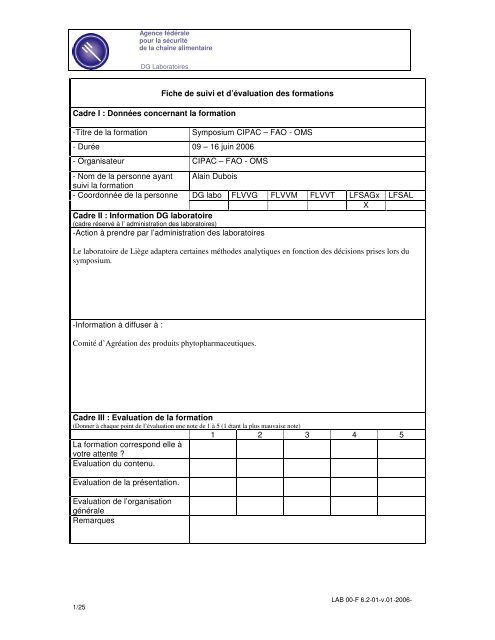
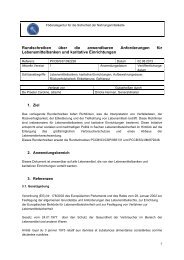
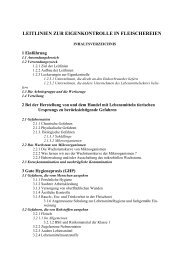

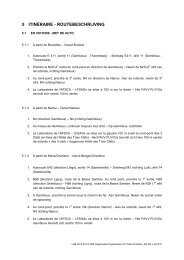
![DPA 2298 Schweine: Aujeszky-Impfung [2298] v2 - FAVV](https://img.yumpu.com/22032815/1/184x260/dpa-2298-schweine-aujeszky-impfung-2298-v2-favv.jpg?quality=85)
